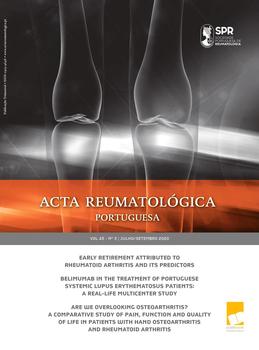Strategies for the withdrawal of classic and biological DMARD in clinically inactive patients with juvenile idiopathic arthritis
Authors
Soraia Azevedo Azevedo; Joana Ramos Rodrigues; Francisca Guimarães; Diogo Almeida; Ana Sofia Pinto; Hugo Parente; Daniela Peixoto;
Objective: To evaluate and describe the strategies of Portuguese rheumatologists and paediatricians, regarding either the maintenance or the withdrawal of classic and biologic disease-modifying anti-rheumatic drugs (cDMARDs and bDMARDs, respectively), when patients with Juvenile Idiopathic Arthritis (JIA) achieved clinical inactive disease (CID).
Methods: We performed a 30-question questionnaire, which was sent to all the 35 clinicians enrolled in the Portuguese group of paediatric rheumatology.
Results: Twenty-three complete responses were obtained. The factors with the greatest impact on the decision to withdraw cDMARDs were: the duration of the CID, the therapy-induced toxicity, the presence of erosive disease and joint damage, the subtype of JIA, the time to reach inactive disease and the low adherence to therapy. These factors were classified as "very important" in this decision by more than 50% of the clinicians. The same factors, except for low adherence, had the greatest impact, when considering the withdrawal of bDMARDs. Withdrawal was more likely in patients with persistent oligoarticular JIA and less likely in rheumatoid factor positive polyarticular JIA. Sulfasalazine was more susceptible to be discontinued than methotrexate. Contrariwise, there were no differences concerning bDMARDs. Most participants reported that they started the drug withdrawal only after 12 months of sustained remission, by progressively tapering the dose of the cDMARD and spacing the intake of the bDMARD. Also, they reported that the decision to suspend the DMARD was based on imaging methods, preferably ultrasound, and in patient-reported outcomes. For patients on combination therapy, bDMARDs are reported to be the first to be withdrawn.
Conclusions: Literature is scarce on this matter and there are no well-defined guidelines on how to withdrawal cDMARDs or bDMARDs on JIA. Notwithstanding, most Portuguese physicians were in agreement on the factors that needed to be taken into account with respect to the withdraw decision.
Soraia Azevedo Azevedo
Unidade Local de Saúde do Alto Minho, Ponte de Lima
Joana Ramos Rodrigues
Unidade Local de Saúde do Alto Minho, Ponte de Lima
Francisca Guimarães
Unidade Local de Saúde do Alto Minho, Ponte de Lima
Diogo Almeida
Hospital de Braga
Ana Sofia Pinto
Unidade Local de Saúde da Guarda, Guarda
Hugo Parente
Unidade Local de Saúde do Alto Minho, Ponte de Lima
Daniela Peixoto
Unidade Local de Saúde do Alto Minho, Ponte de Lima
Unidade Local de Saúde do Alto Minho, Ponte de Lima
Joana Ramos Rodrigues
Unidade Local de Saúde do Alto Minho, Ponte de Lima
Francisca Guimarães
Unidade Local de Saúde do Alto Minho, Ponte de Lima
Diogo Almeida
Hospital de Braga
Ana Sofia Pinto
Unidade Local de Saúde da Guarda, Guarda
Hugo Parente
Unidade Local de Saúde do Alto Minho, Ponte de Lima
Daniela Peixoto
Unidade Local de Saúde do Alto Minho, Ponte de Lima





